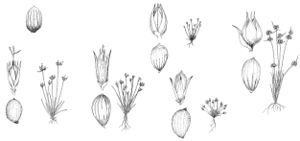Herbs, annual, cespitose, 0.3–1 dm. Culms to 20. Leaves basal; auricles absent; blade 0.5–2.5 cm × 0.5 mm. Inflorescences: glomerules 1–2, each with 2–10(–14) flowers; bracts subtending inflorescence 1(–2), foliose, clearly surpassing inflorescence. Flowers: tepals 6, tan to brownish, subulate, lanceolate-ovate, 3.5–4.5(–5) mm, 2 times length of inner tepals, margins scarious; inner series delicate, shorter, apex acute; stamens 3, filaments 1 mm, anthers 0.5 mm; style 0.4–0.7 mm. Capsules tan to reddish brown, 3-locular, globose to obovoid, 1.2–1.7 mm, shorter than tepals. Seeds ellipsoid-ovoid, 0.3–0.4 mm. 2n = 18.
Phenology: Flowering and fruiting spring.
Habitat: Moist to wet areas, usually in sandy, often disturbed soil such as roadsides or along trails
Elevation: below 1000 m
Distribution
Loading map...

Introduced; Calif., La., Okla., Tex., native, Africa (north), Europe, Asia (Near East).
Discussion
Selected References
None.
Lower Taxa
None.
